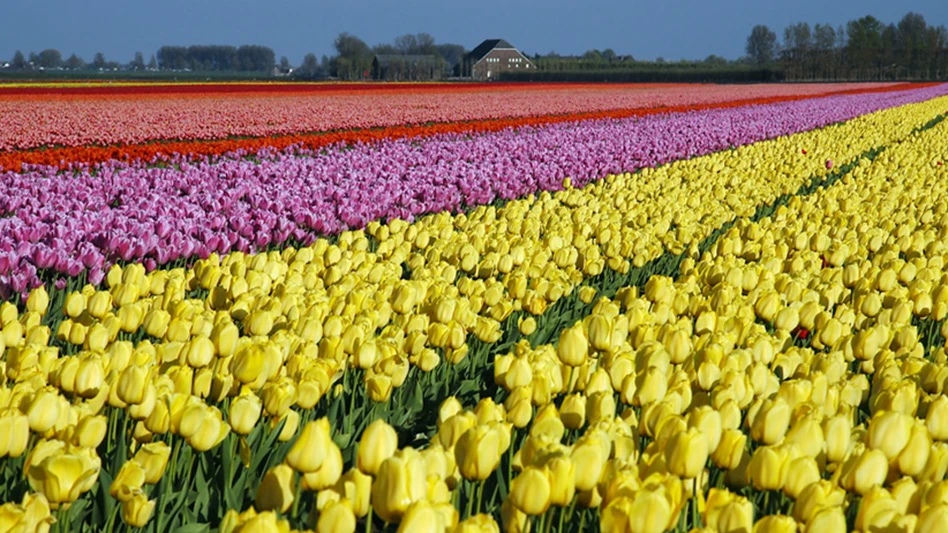 Kalanchoe blossfeldiana has been a standard indoor flowering potted plant in the
Kalanchoe blossfeldiana has been a standard indoor flowering potted plant in the
Calandiva was bred by Fides Goldstock Breeding in the
* * * *
Unrooted cuttings can be planted in finished containers (2- to 9-inch sizes are commonly used), filled with a well-drained growing medium with a pH of 5.5-6 and electrical conductivity of 0.5. Fertilization ratio during propagation should be 1 nitrogen:1 phosphorus:1 potassium. Maintain a growing medium temperature of 70F-74F. Cuttings root in about three weeks depending on variety and environmental conditions. Rooted cuttings are also available from licensed propagators.
One cutting is usually stuck in containers up to 5 inches. Multiple cuttings should be used for larger containers.
The production period can vary depending on cultivar, season, pot size, environmental conditions and whether plants are grown pinched or non-pinched. Response time varies between summer and winter. The production duration for unrooted cuttings can be from 14 weeks in summer to 18-21 weeks in winter. The response time for Calandiva plants is usually one to two weeks longer than other Fides kalanchoes. Response time is still considered short compared to other kalanchoes on the market.
Kalanchoe is a short-day plant with a critical photoperiod of 12 hours. During winter (Sept. 15 until March 31), plants must receive additional light (cyclic or supplemental) to remain vegetative. From March 15 through Oct. 15, plants require short days (14 hours of darkness) to initiate flower buds. A minimum of six weeks of short days is needed, although it is recommended to maintain short days until flowering, which can help produce more compact plants.
Basic fertilizer ratio should be 3:1:3 (N:P:K) until bud formation. During the flowering period the ratio should change to 2:1:4 or 3:1:4. Supplemental application of major elements including calcium and magnesium and trace elements, particularly iron and manganese, may also be necessary.
When light levels begin to exceed 6,000 footcandles, some type of shading is required to prevent leaf reddening and bleaching of flowers.
Optimum production temperature range day and night is between 64F and 68F. When temperatures drop below 61F, plants are delayed and can cause blind shoots or no flowering at all. Below 55F, growth is drastically reduced and no flowering occurs. Night temperatures above 72F can cause blind shoots or no flowering with some growth delay. Above 84F, plants risk heat delay and stretching. Above 93F, there is a risk of no flowering at all.
Relative humidity should remain at a constant level of 75-85 percent. High humidity levels above 90 percent can result in loss of leaves, yellow leaf spots and damaged flower heads and buds.
Plants have good basal branching so no pinching is required. B-Nine and Bonzi have been shown to be effective plant growth regulators on kalanchoes for controlling plant growth.
Specifics
Name: Kalanchoe blossfeldiana
Crop timing: Starting with unrooted cuttings, plants finish in 14-21 weeks depending on environmental conditions, season, cultivar and pot size. Starting with rooted cuttings can shorten the production time by as much as three weeks.
Grower benefits: Plants don't have many pest or disease problems; can be grown relatively cool; and have a long flowering period. The Calandiva series is very uniform and the response time (11-11 1/2 weeks) is very similar between cultivars. Plants can be grown in separate pots or used in combination planters.
Selling points: Multiple flowers, available in 10 colors, last from six weeks to three months. Potential landscape plants. As plants acclimate to outdoor conditions, flower colors brighten and become more intense.
{sidebar id=1}
For more: Fides North America, P.O. Box 1860, 4050 Alajuela, Costa Rica; telephone 011 (506) 442-1849; fax 011 (506) 442-0556; info@Fidesnorthamerica.com; www.fidesnorthamerica.com.
Latest from Garden Center
- Top tips from plant stylist Hilton Carter at TPIE
- Watch the live replay of The Garden Center Group's Cool Products Awards ceremony from TPIE 2025
- Weekend Reading 1/24/25
- How garden centers can leverage plants in floral design
- Hoffman Nursery announces David Hoffman as CEO, Craig Reynolds as COO
- Magic & mystique
- National Garden Bureau announces 2025 Green Thumb Award winners
- Applications now open for American Floral Endowment graduate scholarships





